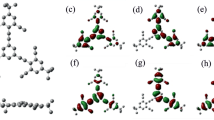Abstract
Dendronized polymers exhibit defined structures with bulky side chains (dendrons) on a linear polymer backbone. Upon reaction with radicals, chromophores close to the backbone were bleached. The reaction rate and yield decreased with increasing dendron size, demonstrating that the inside of dendronized polymers can be “shielded” by bulky dendrons from access by reactive species.
Similar content being viewed by others
Notes and references
A. D. Schlüter, J. P. Rabe, Dendronized Polymers: Synthesis, Characterization, Assembly at Interfaces, and Manipulation, Angew. Chem., Int. Ed., 2000, 39, 864–883.
H. Frauenrath, Dendronized Polymers - Building a New Bridge From Molecules To Nanoscopic Objects, Prog. Polym. Sci., 2005, 30, 325–384.
M. Marcos, R. Martín-Rapún, A. Omenat, J. L. Serrano, Highly congested liquid crystal structures: dendrimers, dendrons, dendronized and hyperbranched polymers, Chem. Soc. Rev., 2007, 36, 1889–1901.
J. G. Rudick, V. Percec, Induced helical backbone conformations of self organizable dendronized polymer, Acc. Chem. Res., 2008, 41, 1641–1652.
A. D. Schlüter, A. Halperin, M. Kröger, D. Vlassopoulos, G. Wegner, B. Zhang, Dendronized Polymers: Molecular Objects between Conventional Linear Polymers and Colloidal Particles, ACS Macro Lett., 2014, 3, 991–998.
Y. Guo, J. D. Van Beek, B. Zhang, M. Colussi, P. Walde, A. Zhang, M. Kröger, A. Halperin, A. D. Schlüter, Tuning Polymer Thickness: Synthesis and Scaling Theory of Homologous Series of Dendronized Polymers, J. Am. Chem. Soc., 2009, 131, 11841–11854.
B. Zhang, R. Wepf, M. Kröger, A. Halperin, A. D. Schlüter, Height and width of adsorbed dendronized polymers: Electron and atomic force microscopy of homologous series, Macromolecules, 2011, 44, 6785–6792.
O. Bertran, B. Zhang, A. D. Schlüter, M. Kröger, C. Alemán, Height and width of adsorbed dendronized polymers: Electron and atomic force microscopy of homologous series, J. Phys. Chem. C, 2015, 119, 3746–3753.
C. Gstrein, B. Zhang, M. Ahmed Abdel-Rahman, O. Bertran, C. Alemán, G. Wegner, A. D. Schlüter, Solvatochromism of dye-labeled dendronized polymers of generation numbers 1-4: comparison to dendrimers, Chem. Sci., 2016, 7, 4644–4652.
Radiolysis is a reaction of chemicals upon ionizing radiation, usually a degradation.
K.-D. Asmus, G. Beck, A. Henglein, A. Wigger, Pulsradiolytische Untersuchung der Oxydation und Reduktion des Nitrosobenzols in wäßriger Lösung, Ber. Bunsen-Ges. Phys. Chem., 1966, 70, 869–874.
Alternatively to the reduction, also a radical addition to the nitro group is possible.13 Our data and interpretation do not depend on the exact mechanism as both reactions will cause bleaching of the chromophore.
V. Jagannadham, S. Steenken, One-electron reduction of nitrobenzenes by alpha-hydroxyalkyl radicals via addition/elimination. An example of an organic inner-sphere electron-transfer reaction, J. Am. Chem. Soc., 1984, 106, 6542–6551.
T. Nauser, G. Casi, W. H. Koppenol, C. Schöneich, Reversible intramolecular hydrogen transfer between cysteine thiyl radicals and amino acids in model peptides: absolute rate constants derived from pulse radiolysis and laser flash photolysis, J. Phys. Chem. B, 2008, 112, 15034–15044.
T. Nauser, A. Carreras, Carbon-centered radicals add reversibly to histidine - implications, Chem. Commun., 2014, 50, 14349–14351.
It is to be stressed that such experiments are only meaningful with a uniform and well-characterized homologous series of denpols.
B. Zhang, R. Wepf, K. Fischer, M. Schmidt, S. Besse, P. Lindner, B. T. King, R. Sigel, P. Schurtenberger, Y. Talmon, Y. Ding, M. Kröger, A. Halperin, A. D. Schlüter, The Largest Synthetic Structure with Molecular Precision: Towards a Molecular Object, Angew. Chem., Int. Ed., 2011, 50, 737–740.
PG3 and l-PG3 are not part of a strictly homologous series. In fact they differ in the chain length and polydispersity index (PDI) (n ofPG3 ≈ 650, n of l-PG3 ≈ 700, see Table S1). Their different initial responses on exposure to iPrOH• (0-10 μs after pulse) may originate from such physical differences.
It is also conceivable that iPrOH• may add to the nitro group of the chromophore before reduction.13 Such an addition process would favour repair in the bulk solution even more.
Author information
Authors and Affiliations
Corresponding author
Additional information
Electronic supplementary information (ESI) available. See DOI: 10.1039/c6pp00191b.
Rights and permissions
About this article
Cite this article
Gstrein, C., Walde, P., Schlüter, A.D. et al. Shielding effects in spacious macromolecules: a case study with dendronized polymers. Photochem Photobiol Sci 15, 964–968 (2016). https://doi.org/10.1039/c6pp00191b
Received:
Accepted:
Published:
Issue Date:
DOI: https://doi.org/10.1039/c6pp00191b




